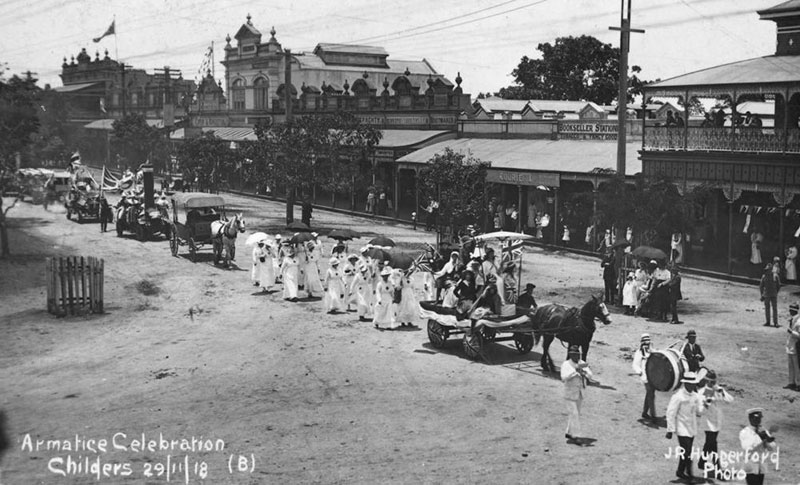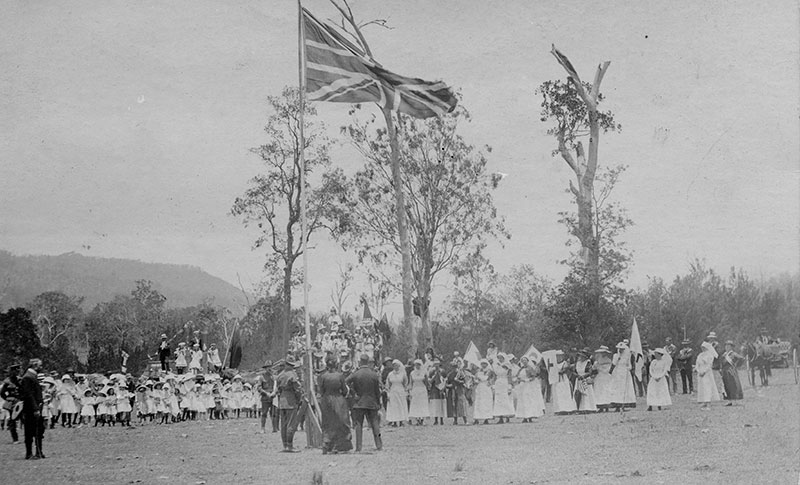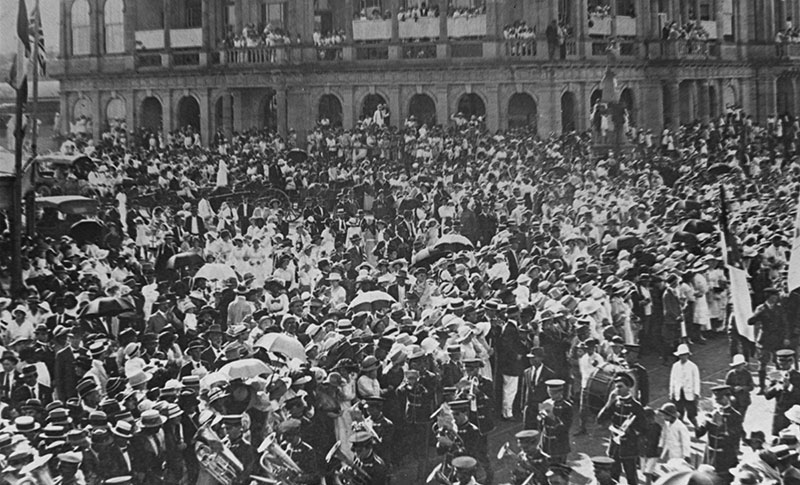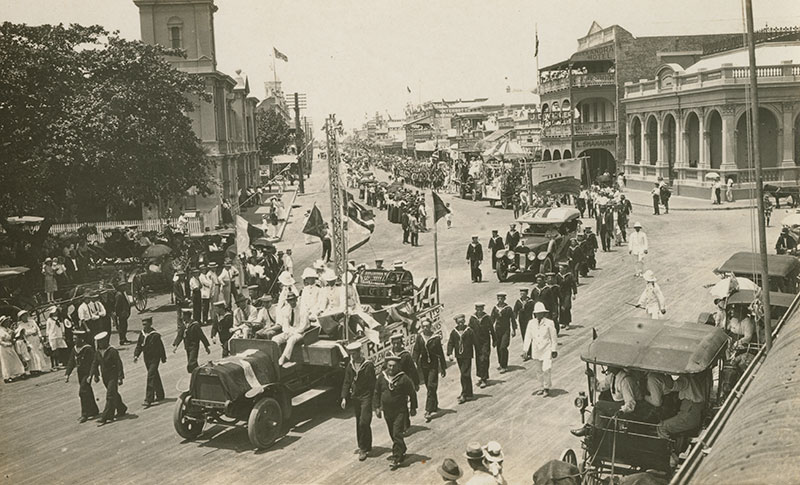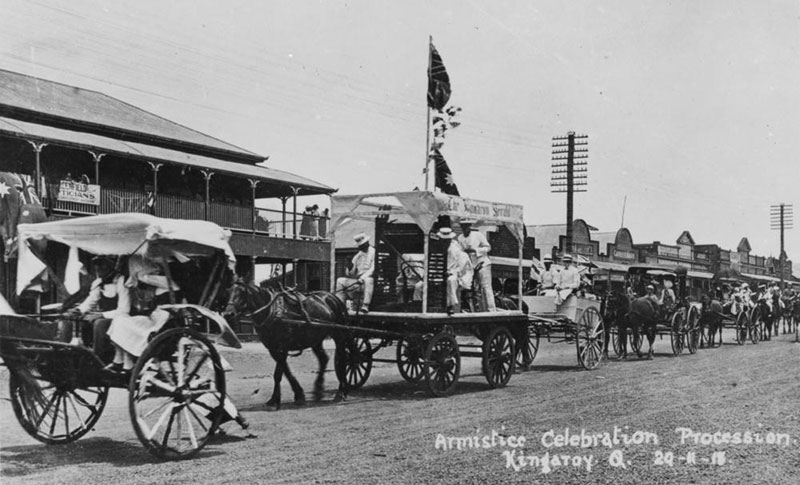History of the Armistice and Remembrance Day
On Sunday 11 November 2018, Queensland joined the nation, and the world, to commemorate the 100th anniversary of the signing of the Armistice, or Armistice Day as it was also known. Read below to learn about this historic agreement that led to the end of the First World War and discover the background and ongoing significance of Remembrance Day.
History of the Armistice
On the morning of 11 November 1918, allied and German officials signed the Armistice, a formal agreement to cease the hostilities of the First World War. When the agreement came into effect at 11.00am, the guns of the Western Front fell silent for the first time in more than four years.
With the fighting on the front lines suspended, the two sides could work towards a peace settlement and negotiate the treaties that would officially end the First World War—most notably the Treaty of Versailles which was signed on 28 June 1919.
Queensland reacts to the Armistice
Armistice facts
- The Armistice agreement is sometimes knowns as the Armistice of Compiegne, which is pronounced [kawn-pyen-yuh].
- The Armistice was signed in a railway carriage belonging to French military commander Marshal Ferdinand Foch. The carriage was stationed in the Compiègne forest, north of Paris.
- The agreement was signed at 5.10am and came into effect at 11.00am.
- By signing, the Germans agreed to immediately cease hostilities, withdraw to the east bank of the Rhine within 30 days, surrender their fleet and heavy guns, and release all prisoners of war, among other conditions.
- In many areas, the fighting continued right up until 11.00am on the day of the Armistice, leading to 2,738 deaths and a further 8,206 injuries.
- On 11 November 1918, few Australian troops were active on the front lines in Europe. That’s because in the previous month, Prime Minister William ‘Billy’ Hughes insisted on a rest period for Australian personnel, acknowledging that over 7,000 countrymen had died and a further 28,000 injured between July and October 1918.
- Many New Zealanders celebrated the Armistice prematurely on 7 November 1918, after local papers reported on a cable from the United States that falsely announced the German surrender.
A day of remembrance
Armistice Day
The signing of the Armistice was such a momentous event that its anniversary—the eleventh hour of the eleventh day of the eleventh month—quickly became a key date of commemoration around the world, known as Armistice Day.
The tradition of stopping at 11am started on the very first Armistice Day in 1919, and continues to this day. It was initially suggested by an Australian journalist living in London, and was made official with a proclamation by King George V. His Majesty requested that “...all locomotion should cease, so that, in perfect stillness, the thoughts of everyone may be concentrated on reverent remembrance of the glorious dead.”

Armistice Day was commemorated annually in Queensland. Here, returned servicemen, nurses and officials participate in an Armistice Day service at Brisbane’s City Hall in the 1940s. (John Oxley Library, State Library of Queensland, George Jackman Photograph Albums, image number 250868)
Remembrance Day
Communities continued to mark the Armistice anniversary each year. However, following the Second World War, the Australian and British governments agreed that the focus should be on all those who died in service of their country (not just the servicemen of the First World War). The day was subsequently renamed Remembrance Day, but its traditions were largely unchanged.
The anniversary’s significance was reiterated in 1997, when Governor-General Sir William Deane issued a proclamation urging Australians to “...observe, unless impracticable, one minute’s silence at 11am on Remembrance Day each year to remember the sacrifice of those who died or otherwise suffered in Australia’s cause in wars and war-like conflicts.”
Symbols and tributes
The poppy
Many will recognise the blood-red poppy as a symbol of remembrance, for its worn on Remembrance Day and at other commemorative events throughout the year.
This tradition has its origins during the First World War and inspired by the fields of poppies that grew in the battle-ravaged fields of the Western Front. In soldiers' folklore, the vivid red of the poppy came from the blood of their comrades soaking the ground.
After attending the funeral of friend and fellow soldier who died in the Second Battle of Ypres in 1915, Canadian doctor Lieutenant Colonel John McCrae wrote the touching and enduring poem In Flanders Fields. It has since become one of the most popular and quoted poems of the First World War.
Moved by Lieutenant Colonel McCrae’s words, in 1918 an American YMCA member Moina Michael vowed she would always wear a red poppy to honour the men and women who fought and helped in the war. She began sourcing and crafting silk poppies for others, and worked tirelessly to share her passion with anyone who would listen.
With the help of organisations such as the American Legion and people like Anna Guérin, a French YMCA secretariat, they took the idea further by selling poppies to raise money for veterans, their widows, orphans, and families.
Eventually Ms Michael’s idea caught on, and soon poppies were being worn with pride all around the world. The tradition continues to this very day, and Australian organisations representing returned defence force personnel provide millions of poppies to the public each year.
There’s no right or wrong way to wear a poppy. The best way to wear a poppy is with respect and pride.
Queensland remembers
In 2014, the Queensland Government committed $49.3 million to support Queenslanders in their commemorations of the Anzac Centenary, from 2014–2018.
This commitment included $2 million towards a state-wide program of Armistice Centenary activities, to enable Queenslanders to appropriately mark the significant anniversary of the Anzac Centenary.
In the lead up to Remembrance Day 2018, there were lots of ways for communities to be involved including:
- making poppies to contribute to the statewide public art installation
- joining Queensland choirs for Voices of Remembrance, a series of Armistice-themed performances
- hosting or attending special community events after Remembrance Day services
- viewing the iconic buildings and landmarks illuminated red or featuring digital projections over the weekend of Remembrance Day (between Friday 9 November to Sunday 11 November 2018
- participating and supporting organisations who delivered events in the local community—whether launching a new publication or unveiling the restoration of a memorial—there were lots of ways to get involved.
This program complemented annual Remembrance Day services, including the state service at the Shrine of Remembrance in Brisbane. We encourage all Queenslanders to continue their strong support of these important annual events and activities.
How Queenslanders remembered
We are proud of Queensland’s commitment to honour the sacrifice of our servicemen and women. Throughout the Anzac Centenary, the community rallied behind events and activities which paid tribute to these extraordinary individuals, their service and their sacrifice.
Many Queenslanders have also developed their own traditions and tributes. These individual commemorations also help keep the Anzac spirit alive for generations to come.


